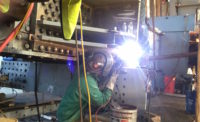Officials say the catastrophic 2007 collapse of the Interstate 35W bridge in Minnesota that killed 13 people revealed shortcomings in visual bridge-inspection techniques, particularly of gusset plates and other components. Mark Bagnard, lead investigator for the National Transportation Safety Board, told attendees at the annual International Bridge Conference, held this year in Pittsburgh on June 14-17, that the state’s load ratings of bridges were inadequately measured and did not include gusset plates.
As far back as 2003, photos showed the gusset plates were bowed. “Despite the photos, this bowing was not reported in either of two inspections.…One inspector actually saw the gusset deformation but figured it happened during construction,” Bagnard said.
Ultimately, the designs of some of the doomed bridge’s gusset plates were found to be half an inch too thin. MnDOT has since inspected 4,500 bridges and implemented a peer- review system for bridge design, said Dan Dorgan, MnDOT bridge director. The state also is addressing gusset inspection. “Initially, there was no software to do gusset-plate inspections, so investigators created it,” Dorgan added.
Malcolm T. Kerley, chief engineer with the Virginia Dept. of Transportation and chairman of the American Association of State Highway and Transportation Officials’ subcommittee on bridges and structures, briefed attendees about NTSB’s recommendations. These guidelines included working with the Federal Highway Administration to develop and implement a bridge-design quality-assurance-control program; revise the “Manual of Bridge Inspection” to include guidance on load ratings; modify guidance and procedures in the “Manual for Bridge Evaluation” and add specifics for gusset plates.
Construction-materials loads on the bridge for a routine repaving job were also a factor in the collapse. Engineers should develop guidelines to prevent this, Kerley added.
An annual investment of $166 billion between 2010 and 2015 is necessary to improve the nation’s highway system, yet in 2006, the nation spent only $78.7 billion on highways. Kerley said. “We have about half the money available that we need to spend,” he added.
“Bridge-inspection requirements must be revised, and we will include those changes in the transportation bill,” said Congressman James Oberstar (D-Minn.). The six-year funding bill is up for authorization this year but faces serious challenges.




Post a comment to this article
Report Abusive Comment